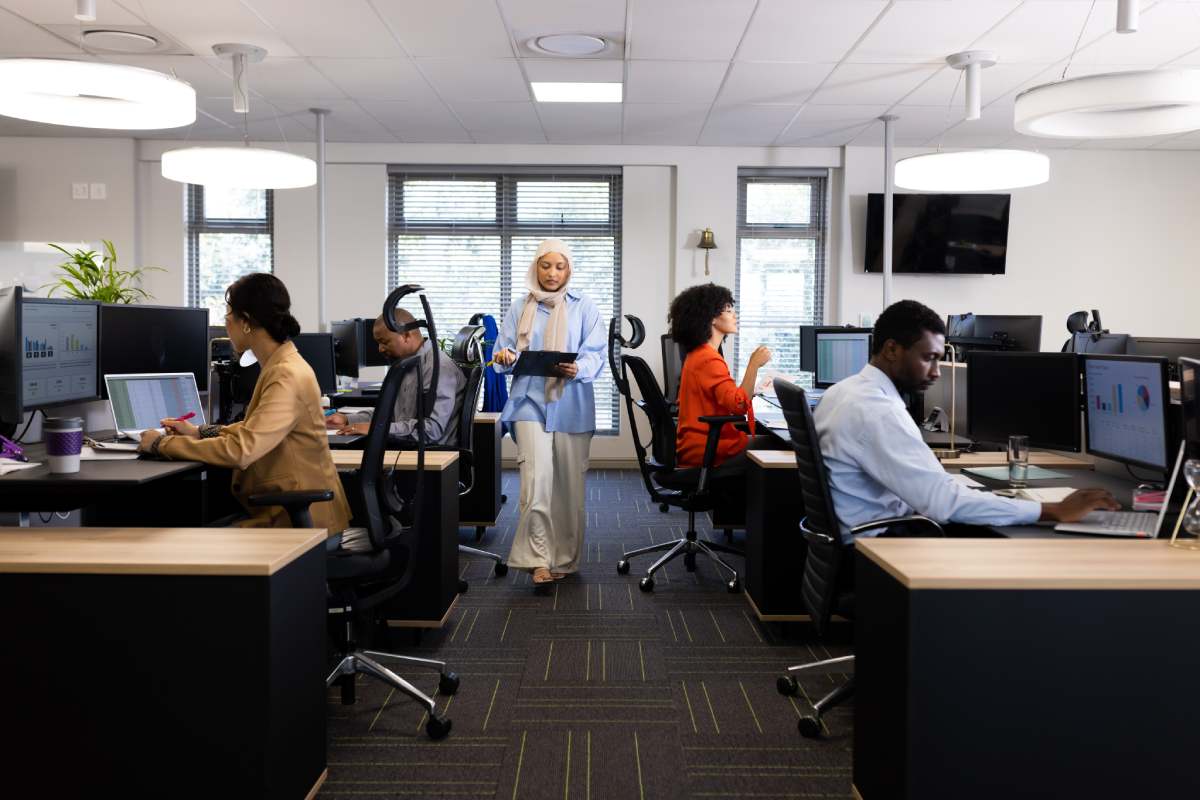The modern workplace is evolving, with open-plan offices gaining popularity as organizations seek to foster collaboration and flexibility among their teams. Unlike traditional cubicles or closed offices, open-plan layouts promote interaction and a sense of unity through shared spaces and interconnected workstations.
While this design offers benefits such as enhanced communication and cost-effectiveness, it also poses challenges like noise and privacy concerns, which can impact employee satisfaction and productivity.
Related article:
- What are office fit outs? What is an office refit? And how do you fit out an office?
- The 3 Main Reasons Why You Need Stone Benchtops for Your Kitchen Renovation
What is an open-plan office?
An open-plan office is a type of workplace layout where employees work in a shared space without partitions or walls dividing individual work areas. Instead of traditional cubicles or closed offices, open-plan offices typically feature large, open spaces where desks, workstations, and sometimes meeting areas are arranged in a fluid, interconnected layout.
This design aims to promote collaboration, communication, and flexibility among employees by removing physical barriers that might otherwise hinder interaction.

Key characteristics of open-plan offices include:
- Shared Space: Employees work in a communal area without private offices or cubicles.
- Flexibility: The layout can be reconfigured more easily compared to traditional office designs.
- Promotion of Interaction: Openness is intended to foster spontaneous communication and collaboration among team members.
- Cost-Effective: Often seen as a more cost-effective use of office space compared to individual offices or cubicles.
- Challenges: Despite its advantages, open-plan offices can also pose challenges such as noise levels, lack of privacy, and potential distractions, which may affect employee productivity and satisfaction.
The popularity of open-plan offices has varied over time and across different industries, with proponents highlighting improved teamwork and communication, while critics point out potential drawbacks related to concentration and privacy.
What are the pros and cons of open-plan office?
Open-plan offices have both advantages and disadvantages, which can vary depending on factors like company culture, work tasks, and individual preferences. Here’s a breakdown of the pros and cons:
Pros:
- Enhanced Collaboration: Open-plan layouts encourage spontaneous interactions and collaboration among employees, which can lead to improved teamwork and idea sharing.
- Cost-Effective: They generally require less square footage per employee compared to traditional cubicles or private offices, making them more cost-effective in terms of space utilization.
- Flexibility: The layout can be easily reconfigured to accommodate changes in team size or organizational structure.
- Improved Communication: With fewer physical barriers, communication between colleagues and across teams can be more fluid and efficient.
- Promotion of Culture: Open-plan offices can help promote a sense of camaraderie and a unified company culture, as everyone is visible and accessible.

Cons:
- Noise and Distractions: Open-plan layouts can be noisy, with distractions from nearby conversations, phone calls, or background noise, which can hinder concentration and productivity.
- Lack of Privacy: Employees may feel exposed or lacking in privacy, which can be a concern for tasks requiring deep focus or confidentiality.
- Reduced Satisfaction: Some employees may find the constant activity and lack of personal space stressful or overwhelming, leading to lower job satisfaction and morale.
- Health Concerns: Increased noise levels and close proximity to colleagues can contribute to stress, fatigue, and even illness in some cases.
- Difficulty in Concentration: Tasks that require intense concentration or focus may be more challenging in an open-plan environment due to the potential for interruptions and noise.
Overall, the effectiveness of an open-plan office depends on how well it aligns with the specific needs and preferences of the organization and its employees. Some companies find great success with open-plan layouts, fostering a dynamic and collaborative work environment, while others may struggle with the distractions and lack of privacy they can bring.
Open-plan vs. Cubicle office
The ongoing debate between cubicles and open-plan offices reflects differing preferences among employees. While open-plan layouts are gaining popularity for promoting collaboration and flexibility, they also face criticism. Some employees thrive in the dynamic atmosphere of open spaces, finding them stimulating. Others, however, feel overwhelmed by noise and lack of privacy, affecting their focus and well-being.
Poorly designed open-plan offices can become chaotic, hindering movement and quiet workspaces, increasing stress and reducing productivity. Employees may feel pressured to perform under constant observation, compounded by noise levels that disrupt concentration.
The impact on employee satisfaction varies widely, influenced by individual needs. Introverts, in particular, may find open-plan environments challenging, needing solitude for productivity. Strategies like using quiet areas, headphones, and clear communication with colleagues can help everyone navigate and thrive in these environments.
Ensuring employee satisfaction in your open-plan office
To ensure your employees embrace your new open-plan office, it’s crucial to prioritize their needs and preferences. The Guardian offers practical advice:
- Engage employees in discussions to understand their needs and preferences.
- Implement strategies to minimize noise, such as using soundproof panels or establishing quiet zones.
- Provide private areas for confidential calls and focused work.
- Encourage employees to personalize their workspace for privacy and comfort.
- Consider offering ergonomic furniture to enhance comfort and well-being.
The debate between cubicles and open-plan offices continues, highlighting both advantages and challenges. While open-plan layouts can foster collaboration, they may also introduce distractions and privacy concerns. Therefore, it’s essential to mitigate these issues by reducing noise, ensuring private spaces, and supporting individual workspace customization.
Cubicles offer privacy and noise reduction but can feel confining. Optimal cubicle design should prioritize natural light, ventilation, adequate space, and storage to enhance employee comfort and productivity.
Ultimately, the choice between cubicles and open-plan offices should align with your employees’ specific needs and preferences. By weighing the pros and cons of each option and considering individual requirements, you can make an informed decision that supports a productive and satisfied workforce.
Conclusion
The cubicle versus open-plan office debate doesn’t have a universal winner. Each workspace style comes with its own set of pros and cons, tailored to the diverse needs and tastes of the workforce. Open-plan spaces are great for fostering collaboration and fresh ideas, but they need a good strategy for noise control and personal space.
On the flip side, cubicles give that much-needed personal area and focus, yet they shouldn’t cut off the chance for team interaction. The key is in valuing what employees think, crafting smart design choices, and accommodating different working styles to shape spaces that boost both work efficiency and happiness.





